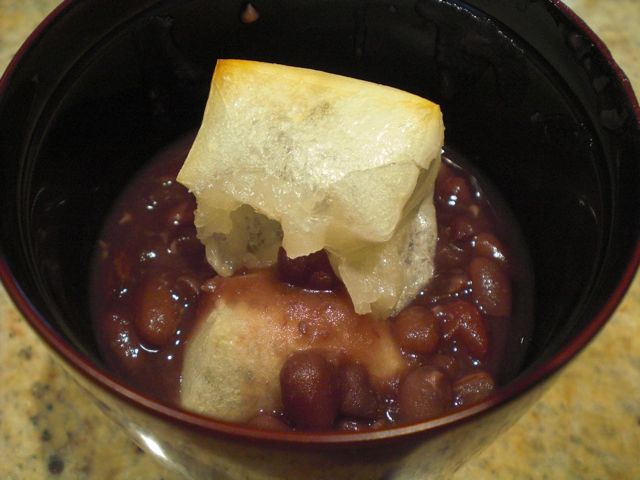This is obviously not Izakaya food at all and is probably the ultimate antithesis of it. I never thought I would be making this dish. But
the aforementioned new gourmet grocery store has a large section of bulk grains and beans. All kinds of interesting items can be found there and you could even grind the grains of your choice or in combination to make your own flours. I actually found red beans or
azuki 小豆 あずき (altenetive spelling, "adzuki"). I have never seen raw azuki beans being sold in the U.S. before* (
canned cooked azuki is available). Tokachi plane 十勝平野 in Hokkaido 北海道, the northernmost island of Japan where I am originally from, is famous for producing azuki. I have never attempted to cook azuki before--and there are reasons that I haven't. The most common use of azuki is to make Japanese sweets called "an" 餡, from which traditional Japanese sweets such as "Yokan" 羊羹 and "Zenzai" ぜんざい etc are made. I do not particularly care for them. They are also used to make "red rice" or "sekihan" 赤飯, a traditional celebratory food, which, I did not particularly like as a kid, liked even less as an adult and avoided eating if at all possible. Despite all this, when I saw the azuki in the bin, I had to get some. I have been in the U.S. too long, perhaps (or maybe the novelty of the situation overcame me).
*I was wrong about this. I simply was not looking for it before. I did find raw red beans, vacuum packed, as well as canned cooked - both sweetened and un-sweetened - red beans in our Japanese grocery store (only one left in DC area).

The above picture is a classic Japanese sweet called "zenzai" ぜんざい or "O-shiruko" お汁粉 consisting of sweet azuki beans and grilled "mochi" rice cake. To my surprise, this was the best version of this dish I ever made. (Since this is the first time I ever made it "best" was not hard to achieve). But above and beyond that it was also the best I ever tasted. Granted, I've only ever eaten it a few times before and that was a long time ago. Even my wife agreed that this was the best she's eaten (she may actually have eaten some in Asakusa as recently as few years ago). If memory serves me correctly, the last time I had this dish was when I was in high school accompanying my classmate (sweetheart).....of course, back then this was something "girls" liked to eat. I recall it was sickeningly sweet and the only reason I ate it was because my classmate wanted some, not because I liked to eat "zenzai" )
In any case, a quick internet search revealed more than a few entries on how to cook azuki properly. I read a few of them and amalgamated them into the recipe I used. I think the secret was that I was careful not to make it too sweet.
Azuki beans look like this (image below left), I think I had about 1 pound. I washed and soaked the beans in plenty of water overnight. I cooked the beans on high flame using the water they soaked in. When the water came to a boil, I turned the flame down to a vigorous simmer (if such a term exists--it is just a tad below "gentle boil") for 10 minutes. I drained and washed the beans in cold running water. I put the beans back in the pot and added fresh cold water (3 times the volume of the beans). After the water started boiling I turned it down to a vigorous simmer. Small white bubbles or scum soon covered the surface, I skimmed it off repeatedly. If the water level went down too far, I added more hot water. After 30-40 minutes, it looks like this (image below right). I tasted the beans, they were now soft. I set aside a portion of the simmering liquid and beans to use for other dishes, and continued making this dish. It appears important to add sugar in stages to keep the beans soft. So I added about 1/4 cup first. I cooked it for a while, tasted it (not sweet enough even for me) and add more sugar until I thought the sweetness was right (for me, that is. It must be a half of the recipe calls for). You could keep cooking to your desired consistency but I like it a bit soupy. I added a pinch (1/2 tsp) of salt at the end which supposedly enhances the sweetness.

I had some packaged mochi in the fridge left over from New Year. I cut the mochi into 4 small squares and toasted it in the toaster oven. (Since the mochi will become very sticky when cooked, I put the cubes on some aluminum foil). When it puffed up and browned slightly, I put it on the top of sweet azuki as see in the first picture.
My wife really liked this but said she would not consider it a dessert--Translation: "Do not attempt to serve this to me as a dessert. If you would like to serve it as a starch side with the meal--perfectly acceptable". In any case, I am planning to make some more savory dishes using azuki. No wine or sake will go well with this dish. "
Bancha"
番茶 or "
Hojicha" ほうじ茶, Japanese roasted tea will be the best bet as your choice of libation.




